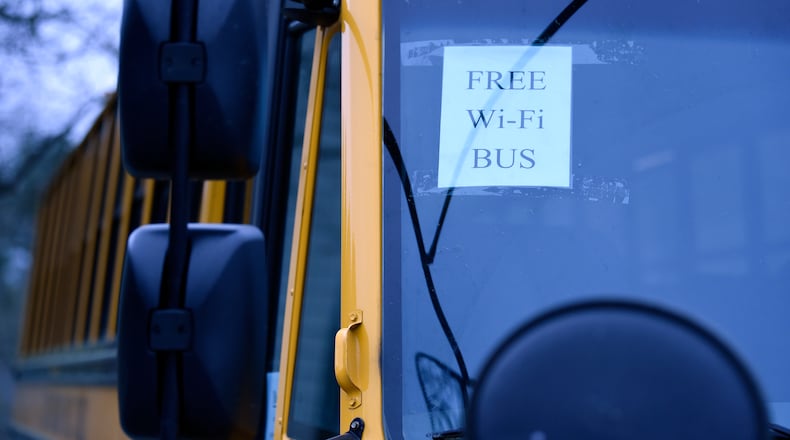State Sen. Elena Parent, D-Atlanta, is co-chair of the NewDEAL Forum Education Policy Group, along with Christopher Cabaldon, mayor of West Sacramento, Calif.
In a guest column today, Parent and Cabaldon urge a national commitment to closing the digital divide, which was seen in stark relief when schools shuttered in March due to the coronavirus. In rural Georgia, students in K-12 and college were going to fast-food and library parking lots to access internet to complete their school work.
By Christopher Cabaldon and Elena Parent
School closures in the wake of the COVID-19 outbreak revealed a difficult truth: The digital divide is real, and it is deep. And the tools we have available to bridge it are insufficient.
As the co-chairs of a group of pro-growth progressive elected officials working on an education agenda for states and cities to better serve students of all backgrounds, we have spent the last several months watching how the virus has affected schools across the country. Recent school closures only spotlighted inequities that have existed for years.
What we heard anecdotally and saw in our own localities was reinforced by new data released by the Alliance for Excellent Education: the nation’s forced experience with online learning was, at best, uneven. And for the students who needed school the most, it was disastrous. One out of three Black, Latino, and American Indian/Alaska Native households lack high-speed internet. Nationwide, across all races and ethnicities, 16.9 million children do not have the high-speed home internet access required for online learning.
Other national data suggest that only 60% of low-income, and 60 to 70% of Black and Hispanic students, logged in regularly to their online classes. For their more affluent peers, the number was close to 90%.
Students who were already behind will be even further behind when school resumes. The research organization NWEA estimates some students may lose as much as a full year of learning.
FCC Commissioner Jessica Rosenworcel calls this issue the Homework Gap – the gap between school-age children who have access to high-speed internet at home and those who don’t. She told us, “We have asked students to join a digital classroom, but they literally cannot get there.” As school districts consider fall plans that could ask millions of students to participate in full or part-time remote learning, the situation threatens to worsen.
Furthermore, the same challenges that affect students’ ability to access their school lessons also prevent them and their families from participating in the telework economy, lifelong learning and credentialing programs, as well as telehealth appointments to support their physical and mental well-being. We must fully recognize the urgency of this crisis.
Our students and their families face problems caused by both availability of broadband and access to existing broadband services. Both issues are harmful to students and families—and both can be addressed if we act now.
There are still wide swaths of the country, most of them rural, where high-speed internet is simply unavailable. These “broadband deserts” exist in every part of the country.
To prioritize where broadband deployment funding can do the most good, we need to know where the gaps in service exist. The FCC’s current estimates consider an entire census block to have broadband available even if only a single home or business can actually get online. So, while current FCC estimates are that roughly 18 million people lack access to broadband, the true number could be 42 million people or even as many as 162 million people, Rosenworcel told us.
The second problem is one of access. Too many households simply cannot afford the monthly cost of broadband even if the infrastructure exists to provide it in their homes. Unfortunately, prior funding provided by Congress in response to COVID-19 did not include targeted funding to close the Homework Gap.
Addressing availability and access requires political will and determination from leaders at all levels of government.
With state and local budgets facing steep cuts, the federal government will need to step in with additional funding for both access and availability. The Alliance for Excellent Education suggests it would cost $6.8 billion to provide students with high-speed home internet and devices. Congress should provide these funds through the federal E-Rate program. The FCC could do even more by allowing existing E-rate funds, which were initially intended to support internet services in schools, to be used outside school buildings, for Wi-Fi hot spots and connected devices.
We can’t stop there. State and local governments should expand programs like deploying Wi-Fi-equipped school buses to underserved areas and providing computers and hot spots to every child. They can also assist the FCC by crowdsourcing data, helping pinpoint broadband deserts.
We need to make a national commitment to closing the digital divide while the impact of this crisis is top of mind with elected officials at all levels. Our country has taken big steps like this before. In 1936, roughly 90% of America’s urban areas had access to electricity, while nearly the same proportion of rural America did not. Then, President Roosevelt signed the Rural Electrification Act, which fostered public-private electric cooperatives. It wasn’t long before the lights went on in rural areas across the country.
We can do it again.
About the Author
The Latest
Featured





